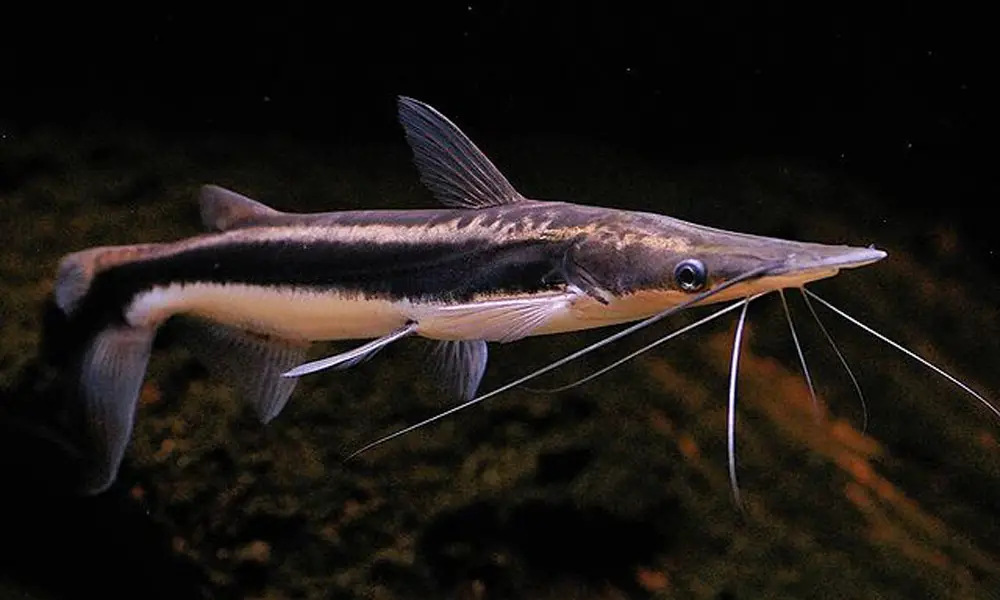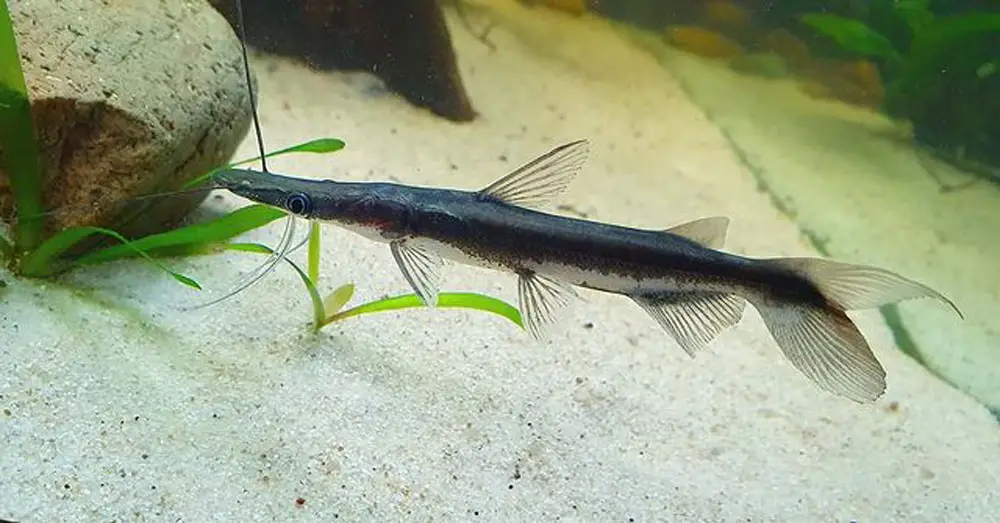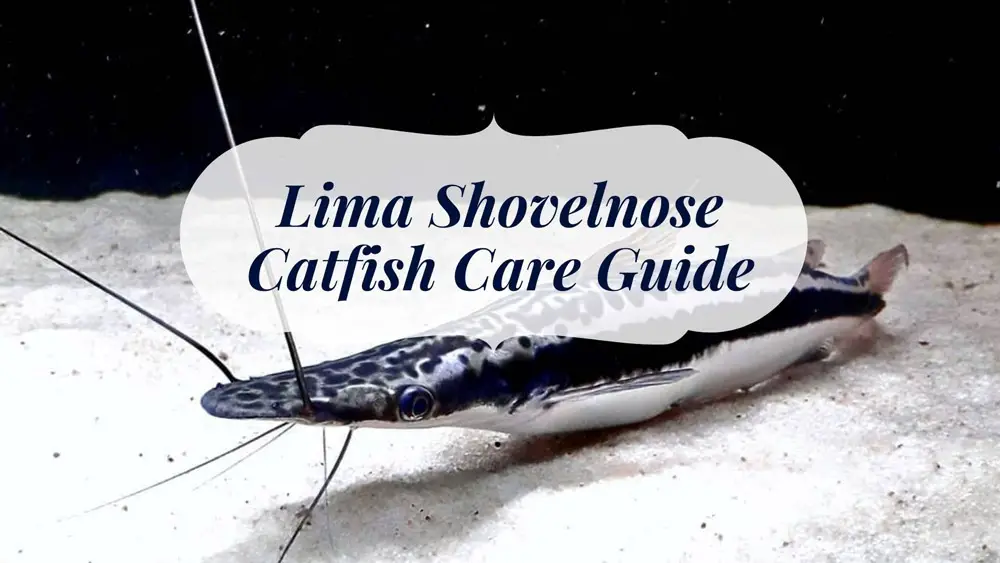Lima Shovelnose catfish are a favorite choice for those with large aquariums. Their unique look and temperamental behavior have actually captured the attention of aquarists for years.
However, these massive fish are part of the aggressive predatory family of pimelodidae; it’s recommended for intermediate and experienced fish keepers.
If you’re thinking about adding this beautiful fish to your collection, here’s what you need to know about Lima Shovelnose catfish care.
Species Summary
The Lima Shovelnose catfish (Sorubim lima) is found in the Amazon and other parts of South America. They derived their name from the shape of their heads. Shovelnose catfish feature flat, rounded heads, which they use as a shovel to get various food items.
This fish is addressed by various names, including Duck-beak catfish, Common Shovelnose catfish, Shovelnose catfish, and Hockey Stick Catfish. As the most widely distributed species of the Sorubim genus, Lima Shovelnose catfish are also a food source for the local people.
There are five recognized species in this genus, including:
- Sorubim cuspicaudus
- Sorubim elongatus
- Sorubim lima
- Sorubim maniradii
- Sorubim trigonocephalus
Sorubim lima has been introduced to other continents for the aquarium trade. Its relative S. elongatus (slender shovelnose catfish) is also part of the aquarium trade, but it’s sold as S. lima. The most significant difference between the two species is their size; S. lima can grow to be up to 22 inches (55 cm), while S. elongatus only reaches a maximum length of 13 inches (32 cm).
In the wild, the Lima Shovelnose catfish spend much of their time moving about the bottom of the water body, searching for small fishes and crustaceans to consume. They are active and aggressive predatory species and will eat most small fish and invertebrates.
| Scientific Name: | Sorubim lima |
| Common Name: | Lima Shovelnose Catfish, Duck-beak catfish, Common Shovelnose catfish, Shovelnose catfish, and Hockey Stick Catfish |
| Origin: | South America |
| Care Level: | Experienced |
| Lifespan: | 18 – 25 years |
| Max Size: | 22″ (55 cm) |
| Temperature: | 76 – 82°F |
| PH: | 6.0 – 7.5 |
| Water hardness: | 1 to 20 KH |
| Diet: | Omnivore |
| Minimum Tank Size: | 180 gallons |
| Temperament: | Aggressive |
| Aquarium Type: | Large Bottom Dweller |
Appearance

Lima Shovelnose Catfish looks visually appealing with their striking coloration of a dark brown upper body and brilliant white belly. Their elegant, streamlined body is a cult favorite among several catfish enthusiasts.
They possess a dark horizontal stripe stretching the entire length of the head and body. Like most catfish, these fish have dorsal and pectoral fin spines with long filaments. You may notice dark blotches or spots on the dorsal surface.
These fishes look amazing when they are small. Young Lima shovelnose catfish are heavily pigmented, with dark stripes running down their sides. However, as they age, their pigmentation fades, and they become much lighter in color.
This change in appearance is thought to be due to the fact that young fish are more active and need to be more camouflage than adults. Whatever the reason, it’s clear that Lima shovelnose catfish are one of the most beautiful and intriguing fish in the world.
Lima Shovelnose Catfish Lifespan
Typically, a shovelnose has an average lifespan of 18 – 25 years in a well-maintained environment, with some individuals living even longer. However, their lifespan in the wild is much shorter, as they are subject to predation and disease.
As always, it’s just an average number, and there are no guarantees. Some specimens may live shorter or longer depending on the quality of care they receive. To prevent any health problems and premature death, you must try to maintain a perfect habitat while providing the best quality food.
Lima Shovelnose Catfish Size
Being one of the smaller Pimelodidae family species, the average size of a Lima shovelnose catfish in captivity between 14 to 18 inches. These fish can grow larger in the wild, with some individuals reaching up to 22 inches (55 cm). Sometimes, aged females are longer.
The purchase size of Lima Shovelnose catfish is generally between 4 to 6 inches. Lima shovelnose catfish grow quickly and can add an inch or two per month under optimal conditions.
Care and Tank Set Up
If you want to give Lima Shovelnose catfish a shot, they have some unique needs you must address. These fish are not recommended for beginners as they require a large tank and special care.
Lima shovelnose catfish are relatively peaceful fish when they’re small, but as they grow older, their predatory instinct will take over, and they will become more aggressive.
Lima Shovelnose Catfish Tank Size
Let’s start with the biggest challenge when it comes to Lima shovelnose catfish care – the tank size. Lima shovelnose catfish are large, active fish that need plenty of space to swim and explore.
The minimum tank size for a single adult Lima Shovelnose Catfish should be at least 180 gallons. However, if you want to keep a small group of juveniles, a small aquarium ranging from 55 to 125 gallons will suffice.
As always, it’s better to err on the side of caution and provide as much space as possible. Lima shovelnose catfish are known to be jumpers, so the tank must have a well-fitting lid to prevent them from escaping.
Water Parameters
When it comes to water conditions, Lima shovelnose seems tolerant of a wide range. These fish mostly inhabit murky, fast-moving clear waters and slow-moving blackwaters in the wild. It’s best to replicate these conditions in the aquarium as closely as possible.
- Water temperature: 76 to 82 degrees Fahrenheit
- pH levels: 6.0 to 7.5
- Water hardness: 1 to 20 KH
- Ammonia: 0 ppm
- Nitrite: 0 ppm
- Nitrate: <30 ppm
Staying on top of water parameters is essential for the health of your Lima shovelnose catfish. Ammonia and nitrite levels should be close to zero, while nitrate levels should be as low as possible.
To maintain stable water conditions, you should do a weekly water change of 30-50%. This will help remove any build-up of toxins and replenish essential minerals and nutrients.
Substrate and Décor
Lima shovelnose prefers a dimly lit tank with a cover of floating plants. You must use large, sturdy, well-rooted plants as small ones will either be up-rooted or buried. Do not forget to provide sturdy hiding places with rocks, wood, or caves. You can also use fine gravel as a substrate.
Another decor need comprises some aptly sized branches and roots of Amazonian plant species that can be arranged to form sheltered areas for Lima Shovelnose.
Food & Diet
In its native habitat, this catfish loves to consume a variety of small fishes, insects, crustaceans, and worms. They will readily accept the same within the aquarium environment.
Lima shovelnose catfish are pretty easy to feed as they generally eat everything you offer. These catfish are carnivorous, which means that they love meat. Hence, it is recommended to provide them with a diet consisting of freeze-friend shrimp and bloodworms.
You can also try chopped-up pieces of fish like Flounder and Cod and mix them with earthworms to add lots of nutrition to their diet. Pellet foods can be considered high in protein but remember that not all Lima shovelnose accept this food initially.
Try starving them for a few days and then offer a small quantity of a few different pellets as the only food. In most cases, Lima shovelnose catfish will eventually accept pellets as a food source. But, it may take longer than other species. Be patience.
- Complete food for large tropical fish such as oscars arowana and large barbs
- Floating foodsticks containing all essential nutrients vitamins and trace elements
- Less waste for cleaner healthier water
- Enhances natural colouration vitality and condition
An added benefit of pellet food is that they don’t spread diseases like feeder fish while providing a more nutritious and balanced diet. Speaking feeding regime, you should feed them once or twice a day.
Keep in mind that Lima Shovelnose shouldn’t be fed large amounts of the mammalian meat as they cannot be properly metabolized by the fish and can cause excess deposits of fat and even organ degeneration.
Behavior & Temperament

Contrary to the belief, Lima shovelnose is a social creature that happily lives with large catfish and groups as long as the tank is large enough. Remember that this catfish is nocturnal, which means they are primarily active at night.
They are widely notorious for jumping out of uncovered tanks; Keeping your aquarium well-covered, especially at night, is recommended.
Also, Lima Shovelnose is highly aggressive, and they generally do the best in aquariums that resemble their natural surroundings. Therefore, you should add sand mix substrate, driftwood, or tree root to the tank and keep them calm and composed.
Juveniles are actively gregarious, while adults are not much aggressive toward one another; hence can be maintained together in large aquaria.
Lima shovelnose catfish Tank Mates
When it comes to the Lima Shovelnose catfish tank mates, you should not put any fish that can fit inside its mouth. The best tankmates are other Lima Shovelnose or other species native to their habitat.
Keep them with bigger fish, and small, slim-bodied fish should be avoided. While adults are not particularly aggressive, they can mistake smaller fish for food, so avoid adding anything that they can swallow.
You strictly avoid Torpedo formed fishes as these catfish grow very fast and might fit in their mouth one day.
Also, it is advised to keep less aggressive and calm tankmates together to maintain the aquarium’s balance. The good tankmates for this catfish must be adequately-sized and less territorial. The list includes:
- Peaceful SA or CA Cichlids
- Loricariids
- Larger characins
- Myleus
- SemaProchilodus flag tails
Cyprinids, Large pimelodids, and other territorial bottom-dwellers are considered less suitable.
Breeding
Unfortunately, there’s no report of Lima Shovelnose catfish breeding in the aquarium, and it is believed that they haven’t been bred in captivity. Moreover, there’s no known way to create an ideal environment or trigger spawning temperature.
Talking about their breeding behavior, it is believed that both male and female Lima shovelnose spin around each other, side by side, while biting each other’s tail before spawning. The rest is a mystery as there’s no info or reports on Lima’s breeding in aquariums available on the internet.
In nature, it has been reported that they wander to unique breeding places; hence, making them breed in fish tanks is very difficult.
Conclusion
So, that’s all about the Lima Shovelnose Catfish caring guide. We hope you have enjoyed reading the post and found it informative. The shovelnose has a classical appearance in the aquarium; hence you can find them even in the most common aquarium shops.
This catfish is a social animal that likes to be surrounded by other shovelnose species. So, if you have a large aquarium and decent water conditions, you should invest in these fascinating creatures. Feeding them isn’t a hassle, making them ideal for beginners as well. Keep in mind that they are predatory fishes; therefore, you should choose the tank mates wisely.
Have fun!






